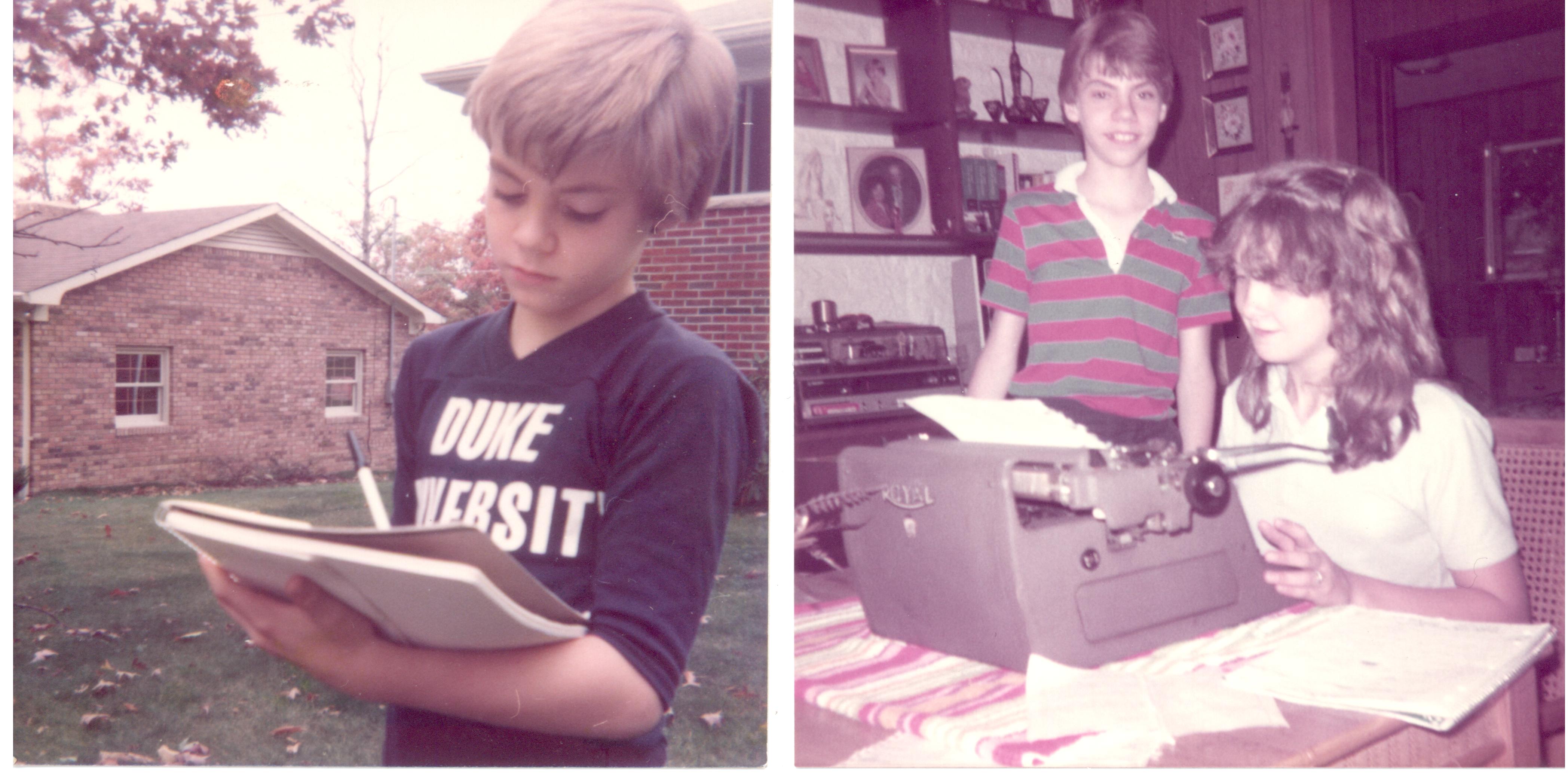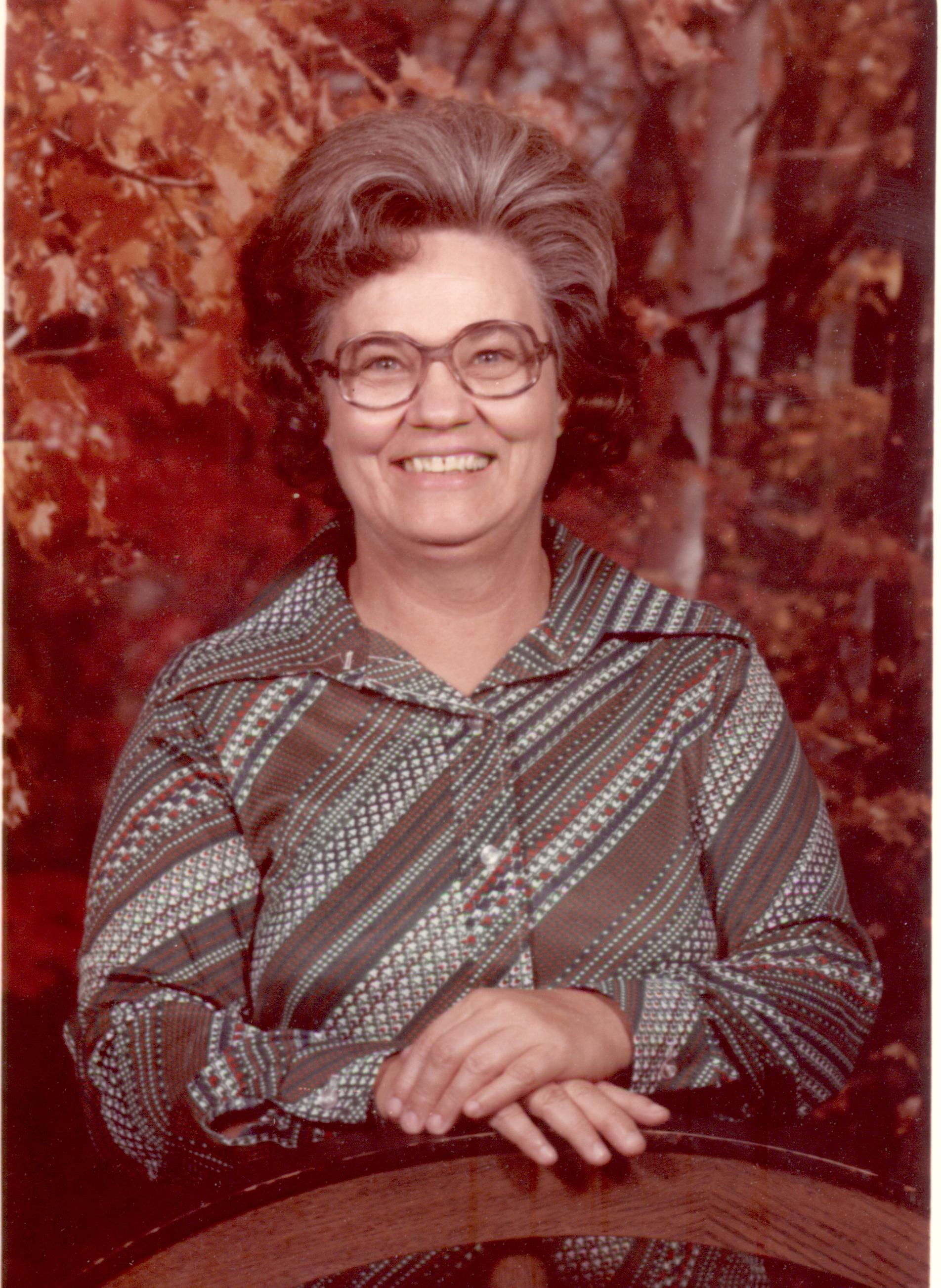
Left: Richard preparing a "lesson" for great aunt Evelyn (October, 1980: Beckley, West Virginia)
Right: Richard and sister Crissy working on a "test" using Aunt Evelyn's manual typewriter (December, 1983: Beckley, West Virginia)
Below: Betty McDorman (image from 1978 Coal City Elementary School yearbook)
I think I always knew that I would eventually become a teacher. When I was in elementary school, I would "play professor" with my great aunt Evelyn, teaching her "lessons" about the alphabet and then preparing her tests, grading them and carefully explaining where she went wrong. She had a very old manual typewriter that I would use to carefully type her tests--I remember how excited I would get on the way to her house, just waiting to get my hands on that unique, ancient treasure.
 My grandmother Betty was an elementary school teacher in Coal City, West Virginia. She was one of the very first women in her town to earn a college degree, and some of my first memories of classrooms were of her second and third grade classes, with seasonally-themed collages neatly arranged on the walls. I have many diverse memories of school. Because my parents worked in the coal industry at time when it was in flux, we moved around a lot. Consequently, I was enrolled in three preschools, three elementary schools, two junior high schools (back when they still existed) and two senior high schools spread across three states and in very different areas, from a remote village of perhaps two hundred people (truly in the middle of nowhere) in central West Virginia with only a single seventy year-old school house in town, to the western suburbs of Pittsburgh and then to a small colonial Virginia town of about seven thousand people, where I went to high school from tenth grade on. As a result of having studied in such varied educational settings, my "apprenticeship of observation" was quite rich, as I was exposed to a great variety of ways of teaching.
My grandmother Betty was an elementary school teacher in Coal City, West Virginia. She was one of the very first women in her town to earn a college degree, and some of my first memories of classrooms were of her second and third grade classes, with seasonally-themed collages neatly arranged on the walls. I have many diverse memories of school. Because my parents worked in the coal industry at time when it was in flux, we moved around a lot. Consequently, I was enrolled in three preschools, three elementary schools, two junior high schools (back when they still existed) and two senior high schools spread across three states and in very different areas, from a remote village of perhaps two hundred people (truly in the middle of nowhere) in central West Virginia with only a single seventy year-old school house in town, to the western suburbs of Pittsburgh and then to a small colonial Virginia town of about seven thousand people, where I went to high school from tenth grade on. As a result of having studied in such varied educational settings, my "apprenticeship of observation" was quite rich, as I was exposed to a great variety of ways of teaching.
I experienced similar variety in my own classroom language studies, which began when I was in grade school (a once-a-week enrichment program that included light instruction in Hebrew) and continued all the way through graduate school (the last formal language courses I took were Classical Aztec--one of the most boring classes I ever had to endure, due mainly to the instructor's dry and emotionless teaching method, which included nothing more than memorizing and translating texts--and Middle Egyptian, which I found somewhat overwhelming since I was taking the class for my non-Indo-European language requirement in the midst of aspiring Egyptologists). Sandwiched in between learning to write Hebrew letters when I was eight and studying the texts of ancient civilizations in my mid-twenties were abundant and diverse language studies that included many years of Spanish, French and Latin, along with two years of Chinese, a year of Arabic, and one semester each of Old English, German, Swahili, Old Provençal and Lakhota (the most widely spoken dialect of the Sioux). Although most of these language courses taught me what not to do when I would eventually become a language teacher myself, I was exposed to one or two excellent teachers whom I would later try to emulate (my Swahili teacher, one of most acclaimed Bantuists and in my humble opinion fantastic teachers in the United States, was particularly inspiring). I also experienced two naturalistic language learning settings when I was a teenager, first during a long summer in Mexico City and the next year at a Spanish language immersion camp for high school students. It was through these two experiences that I actually acquired the ability to use a foreign language for the first time. I made greater gains in Spanish proficiency in these two summers than during all of my years of formal Spanish classes combined. As a result of these experiences, I came to believe (and still do) that learning a language naturalistically, in situ, is a far more effective way to acquire fluency in a language than classroom-based learning. For despite our best efforts, I believe that it is impossible to recreate a truly naturalistic learning environment in the classroom. The best we can do is to simulate real-world conditions and scenarios, but I believe that there will always be an artificiality to the classroom that cannot be completely eliminated.
My first real teaching experience took place in the early 1990s, when I was teaching (or rather trying to teach) English as a second language to Mexican migrant workers and their children in Central Virginia. I remember those experiences vividly, as our small group of aspiring teachers would board a van, bubbling with enthusiasm and excitement, to travel about an hour away from the University of Virginia campus to the apple orchards south of Charlottesville. I recall being shocked upon seeing the deplorable living conditions of the workers and their children, who were huddled into what looked like (and very well might have been) dilapidated antebellum plantation workers' quarters and trying my best to present the weekly lesson to exhausted workers with perplexed looks on their faces. I remember that most of my lessons to these learners were in Spanish, not English, and that we talked about Mexico and Central America a lot. My second teaching experience took place when I was in graduate school in Chicago, where I taught two sections of first-year conversational Spanish. I received absolutely no training whatsoever for the job and was selected because I was the only graduate student in the linguistics department who was proficient in Spanish. Although I did the best I could (trying to emulate the few good language teachers I had learned from in the past while trying to avoid the habits of the bad ones), I barely managed to stumble my way through the year. What I remember most about the experience was being chastised by the program supervisor for misusing the word cuestión during a class and always struggling to hold the attention of my students, almost all of whom were in the class because they thought that taking first-year Spanish was the least painful way to satisfy their mandatory foreign language requirement.
These were the formative experiences that, at least as far as I am aware, have most powerfully shaped my ideas about teaching. By the time I started teaching English full-time at a private language school in Miami in 2003, I suppose that my ideas about what "good" language teaching should be like were already long settled. One of the common threads that runs through all of my language teaching experiences is that I had very little formal training in how to actually teach (as opposed to the subject matter itself, in which I was thoroughly well schooled), and pretty much had to figure it out own my own as I went along based on my prior observations and experiences.
Leave a comment